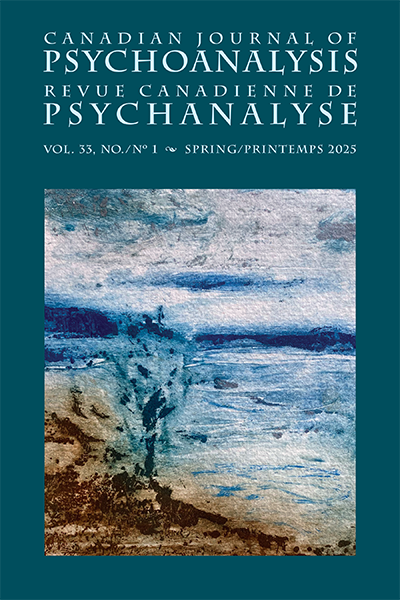Vol. 33, No. 1, Spring 2025
Contents
INTRODUCTION
Louis Brunet, Margaret Ann Fitzpatrick Hanly, Marie Claire Lanctôt Bélanger, Darren Thompson
Download (PDF)
ARTICLES
The Thing-Presentation Revisited in the Context of Sexual Anxieties: A Modern Ego Psychology Approach
Les Fleischer
This paper illustrates the importance of the thing-presentation in clinical work by examining sexual thing-presentations. A modern ego psychological conceptualization of sensory emotional representations (thing-presentations) can enhance our understanding of conflicts around sexuality and intimacy and illuminate unconscious emotional dynamics underpinning sexual experience. I present two case vignettes that demonstrate how the identification and analysis of thing-presentations can deepen treatment for some patients who suffer from sexual inhibitions, difficulties with intimacy, and unsatisfactory object choices/relations. I also address the importance of locating thing-presentations within the context of a modern ego psychological framework.
Keywords: thing-presentation, modern ego psychology, symbolic representations, sexual experience, compromise formation
What Does Poetry Offer Psychoanalysis? Wallace Stevens: “Connoisseur of Chaos” and Stevens’s Notion of Motion
Cecilia Taiana
In this final article of three, the author responds to W. R. Bion’s question, “What kind of poets and artists can [psychoanalysts] be?” The author explores the concept of imagination in psychoanalysis, drawing connections between Wallace Stevens’s ideas and the work of Balint, Winnicott, Bion, and Laplanche. Stevens’s imagination, “unsponsored by the holy,” provides an entry into poetry as a process in statu nascendi, where the sensuous and the psychic bind, emphasizing the importance of cultivating sensitivity to the emergence of consciousness. Imagination, like a dream, operates through displacement and condensation, using metaphors and metonyms to reshape reality. Stevens conceives poetry as “the life that is lived in the scene it composes” rather than the things themselves. The author argues that imagination is essential for self-preservation and that its expression—the sound of its words—helps us live our lives. The author also examines Stevens’s notions of chaos and motion, and the ego’s binding function as anti-motion or metastability. The article concludes by highlighting how Stevens’s poetry reflects the idea of motion inherent in both the natural and psychic worlds.
Keywords: imagination, chaos, motion, metastability, preconscious, sensory and psychic binding, poetic experience, dreamwork, displacement and condensation, self-theorizing subject, psychoanalysis and literature
Remémoration, répétition et perlaboration : du souvenir à la construction, ou Vivre pour la première fois (de Freud à Winnicott)
Emmanuel Piché
This article seeks to bridge the gap between the work of Freud and that of Winnicott regarding the question of recollection through repetition. It underlines the failures of the process of recollection in certain clinical situations, which will lead Freud at the end of his life to speak of construction, while Winnicott will be led to evoke traumatic experiences which have not been psychized, which therefore cannot be remembered, but rather must be experienced for the first time in order to be integrated into the psyche. Between repressed childhood experiences and others which are split, a different posture is called for the analyst. Two clinical presentations will be used to illustrate this point.
Keywords: remembrance, repetition, construction, repression, splitting
Analysis Terminable and Interminable According to Lacanian Psychoanalysts’ Dreams
María Celeste Labaronnie, Bruno Colantoni
This article derives from broader research about the changes in dreams throughout psychoanalysis and especially at its termination. The written dreams of several Lacanian analysts are used. We propose that there is an exhaustion of the process, a satisfaction obtained and a temporal divergence between these two moments. Regarding the transference, we suggest that these dreams depict a situation composed of two aspects: (a) something that concludes: the relationship with the analyst; and (b) something that opens up: the possibility of continuing the (self)analysis thanks to the relationship with others, especially colleagues.
Keywords: dream, analyst, termination, Lacan, pass
The Paradigm of “the Double” in the Psychotherapy of Narcissistic-Identity Suffering
Johann Jung, Alexandre Francisco
Narcissistic-identitarian suffering is at the centre of many current clinics and concerns a wide range of disorders. More broadly, it refers to a set of problems that hinder, in an intermittent or lasting way and to varying degrees, the subjective identity of individuals and the psychological processes that are linked to it. The treatment of narcissistic identity pathologies reveals a double relationship during the transference-countertransference process that refers to deep layers of identity. Illustrated with a clinical case study, this article posits that this double relationship, in its different modalities, plays the role of a transference attractor that supports potential transformations of the identity. The emergence of this double relationship during transference and the painful affects that come with it, can allow the patient, with the support of the reflexive function of a clinician able to survive the patient’s destructivity, to reorganize his/her relationship to him/herself and to the other.
Keywords: double relationship, identity, narcissistic-identity suffering, reflexivity, subjectivation, transference
Traumatisme de la naissance et addictions : approche théorique et perspectives thérapeutiques du climat d’angoisse…
Isabelle Boulze-Launay, Alain Rigaud, Corinne Gal
Based on the prototypical relationship between the experience of the birth trauma and that of the addict(s) in psychotherapy, we will describe the disarray of the anguish caused by this early trauma, which has led to an over-investment of the mind and the maintenance of a climate of anguish. We will then illustrate the need to think of therapeutic encounters with patients in terms of holding in institutions. The aim is to set up a mechanism capable of calming anguish, in order to propose a psychic birth in the therapeutic space, within a framework that inspires confidence. We will then give some clinical examples of reception and therapeutic follow-up, emphasizing the role of holding. Finally, we will show how, within the psyche, this therapeutic framework can facilitate new creative interweavings of body and language in the space of a transference clinic. The psyche-inhabiting-soma encourages a rereading of the initial pairing of trauma and anguish, so as to better separate from it and exist.
Keywords: addiction, trauma, anguish, holding, psychotherapy
Surrounded by Expectations and the Loss within Achievement
Robert Waska
Two case reports will be used to demonstrate psychoanalytic work with patients who are obsessive in their need for achievement and are constantly anxious or guilty about failing. These object relational phantasies involve being noticed, valued, and loved as well as the fears of being unnoticed, weak, and alone.
Keywords: modern Kleinian therapy, demand, loss, expectation, projective identification, achievement, working through
REVIEWS
How Does Analysis Cure? Essays on a Psychoanalytic Method, Psychoanalytic Organizations and Psychoanalysis by Fred Busch
Reviewed by Gohar Homayounpour
Que deviennent les répétitions ? Présent de la psychanalyse, nº 12, Association psychanalytique de France
Recension par Gilles Fauvel
Download the Table of Contents (PDF)
Previous Issues
Vol. 32, No. 2, Fall 2024
(Download table of contents PDF)
Vol. 32, No. 1, Spring 2024
(Download table of contents PDF)
Vol. 31, No. 2, Fall 2023
(Download table of contents PDF)
Vol. 31, No. 1, Spring 2023
(Download table of contents PDF)
Vol. 30, No. 2, Fall 2022
(Download table of contents PDF)
Vol. 30, No. 1, Spring 2022
(Download table of contents PDF)
Vol. 29, No. 2, Fall 2021
(Download table of contents PDF)
Vol. 29, No. 1, Spring 2021
(Download table of contents PDF)



